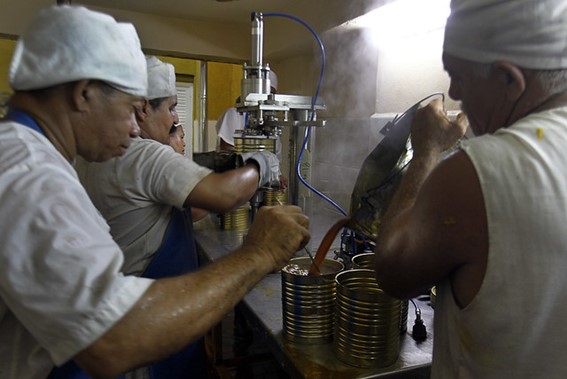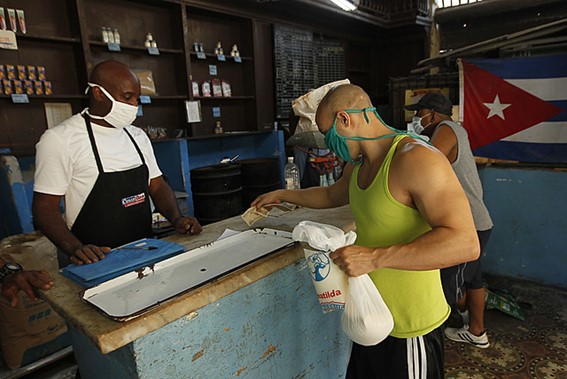Cubans Uneasy over Upcoming Salary/Price Increases
Could D-Day be December 1st?
By Luis Brizuela (IPS)

HAVANA TIMES – Eloína Estupinan, 67, retired, is concerned about the announced monetary reorganization in Cuba. It’s billed as a necessary and complex process with an impact in all spheres of life on the island.
“The issue has been discussed for a decade, but the time to face it will be very difficult. The stores are practically empty and food prices are almost inaccessible for a pensioner like me. I hope it helps to fix the economy and improve our lives,” she said from the city of Holguin by phone.
Soraya Martínez, a Marketing Professor, hopes the reorganization “breaks with a hackneyed cycle of measures and is a real step to get somewhere.”
“I hope it achieves its main objective, to stimulate the production of goods and services and improve salaries.” Martinez spoke with IPS in a virtual exchange from the city of Santa Clara.
The first details came in mid-October
On October 12 -13, government authorities offered details on national television about the end of monetary and exchange duality. A process known in official jargon as the Ordering Task, which for many citizens has taken too long.
The officials did not specify the exact date adding to the suspense. They just indicated it will take place on the first day of a certain month. However, for many the process is imminent.
[Editor’s note: For those having capital and insider information on the implementation date a sizeable profit is in the offer. The government says salaries and prices are going to increase drastically. Therefore, divesting Cuban currencies and buying up any product/s for resale should turn a big profit. The other strategy is purchasing US Dollars on the illicit market to protect savings, since the government collects them but doesn’t sell them.]
“Today our monetary environment and structural problems make it difficult for the economy to work properly, and needs to be ordered,” said Marino Murillo, who Heads the Communist Party’s Commission for the Implementation of the Guidelines.
It is precisely in the Guidelines that the need for the country´s economic and financial reorganization is set up. The Guidelines were first approved in 2011 but never implemented. After a process of analysis, the Party made modifications in 2016, but that too proved an exercise in futility.
The dual monetary system began in the 1990s crisis
The monetary and exchange duality was a measure derived from the early 1990s crisis. The collapse of the Soviet Union and the Eastern Europe socialist bloc, its main markets and creditors, brought Cuba to a near halt.
In 1993, the government decriminalized the circulation of the US dollar to compensate for the devaluation of the Cuban peso (CUP).
The US dollar was replaced in 2004 by the Cuban convertible peso (CUC), which was on par with the dollar. However, different exchange rates were applied with respect to the CUP, the currency that will remain. The CUC became the currency used by visitors at all hotels, most restaurants and tourist spots.

Authorities claim that such a distortion prevents an adequate analysis of the economic and financial situation of State companies. Likewise, not having indicators that correlate with the world market. In addition, the impact on wages, prices and subsidies for certain services and products will be considerable.
There have been signs in recent years
In recent years, some decisions accelerated the path towards currency unification. The payment option in both currencies, CUC and CUP, at government shops. Then the implementation of currency exchange only in CUP in some establishments. The printing of higher denomination bills, among others.
However, the uncertainty in part of the population, regarding the measures, lies in the convergence of several simultaneous processes. Nonetheless, according to Cuban professor and economist Ricardo Torres, they will have gradual impact.
From the unknown Day Zero, the unification process starting date, the CUC will stop circulating. Exchange rates will be unified. The CUP will be devalued. Wholesale and retail prices will increase. Certain subsidies will be eliminated, and salaries and pensions will increase, Torres explained.
What will the end to subsidized rations mean for low-enders?
As officially announced, the increase in workers and pensioners’ income -five times on average- will eliminate the subsidized prices of a basic quota of food and other products. Although insufficient, the Government offers these every month to 11.2 million residents in the country, through a ration book instituted in 1962.
“Even if wages and pensions rise, so will the prices of products and services. I have savings in the bank that will lose purchasing power when the CUP is devalued. I cannot stay calm”, said Rogelio Cespedes, a carpenter living in Havana.
Cespedes also told IPS about the availability of supplies in the few wholesale markets for the cooperative and private sectors. How far the prices of products and services of non-state workers will rise in the new context is a big question mark. The government says 13 percent of the country’s workforce is outside its priority State sector.

An executive report by the autonomous consulting company AUGE was published on November 12. It explained some of the monetary reorganization implications for Cuba’s private sector. It offers to assist in the decision-making process in an unprecedented context.
Supply costs and wages to sharply increase
Among the main consequences mentioned will be the increase in supply costs and modification of wages. There will also be a decrease in the tax burden and operational fees. However, the gap between available working capital and the new amounts to be disbursed for supplies is a concern.
According to the Consulting company, other possible impacts could be related to the dollarization in the short term. This will mean an increase in the supplies that can only be purchased in a currency that Cubans don’t earn. Since October 2014, AUGE has provided advice to businesses in terms of strategy, marketing and communication.
The sending of cash remittances and goods to Cuba fell 54.1 percent in 2020, from $6.616 billion dollars in 2019 to $2.967 billion so far this year. This is attributed to the impact of the coronavirus pandemic, reported The Havana Consulting Group (US) on November 24.
Emilio Morales, president of Havana Consulting, believes this “has represented a severe blow” for the well-being of the Cuban population. A people already heavily punished by the “scarcity and low wages paid by the Government.”
Not exactly a favorable time
The monetary and exchange reorganization will occur at an unfavorable time for the national economy. Its main sources of income: professional services, tourism and remittances, were weakened by the effects of the pandemic.
Add to that, the non-payment on the foreign debt and the effects of numerous sanctions by the Trump administration. US policy has focused on cutting off the entry of foreign currency to the country. Likewise, the strengthening of the embargo that Washington applies against Cuba since 1962.
With structural and efficiency problems, decapitalization and meager growth in recent years, Cuban economy should experience a no less than eight -percent contraction of its Gross Domestic Product in 2020, estimates the Economist Intelligence Unit and the Economic Commission for Latin America and the Caribbean (ECLAC).
Cuban economist Mauricio de Miranda notes that even the elimination of the CUC does not ensure full monetary unification. He cites the partial dollarization of the economy since 2019, with the opening of stores selling only in US dollars.
Other foreign currencies can also be dollarized and put into the accounts. The account holder gets a magnetic card for shopping for a wide range of goods. These include basic foods and hygiene products in high demand but in great shortage in Cuban peso markets.
Authorities have said that the decision to attract foreign currency is necessary and temporary. However, experts believe it represents an additional challenge by opening a new market segment and a source of greater inequality.






As long as the Cuban economy operates on more than one currency, there will be economic hardships for the Cuban population. The Cuban economy pays its workers with Cuban pesos which contain very little value. On the other hand, there is the mighty American dollar which Cubans view as superior and has an extremely high purchasing power. The problem is that the majority of Cubans deal with devalued Cuban pesos while the minority have the fortunate opportunity to use American dollars. Severe inequality in Cuba is the obvious result of this extreme disparity.
To an outsider, the Cuban government seems to be propagating this inequality further by opened dollar stores operating only in American currency and the stores are abundantly stockpiled with essentials that every Cuban would dearly like to buy if they had the appropriate currency. Unfortunately, the Cuban peso, the national currency of Cuba is shunned at these dollar stores leaving most Cubans empty handed for essential products.
At the local market which operates in the national currency, there is little to purchase because the Cuban government wants to fill its coffers with a currency that has significant value on the world market and that currency is the American dollar.
Remittances from foreigners a national treasure for the Cuban economy are highly appreciated. The expulsion of Western Union, a significant operator in the remittances monetary channel has been deleted by the Trump administration contributing to further economic currency problems for the Cuban administration.
Cubans certainly do need to worry about salary and price increases. Any salary increase, probably seen as a good thing initially, will be wiped out by the increase prices in basic necessities, like food prices, because of inflationary pressures. This classic economic scenario causes too much money chasing too few goods in the closed economy leading to extremely inflationary prices which is always a negative for the ordinary Cuban trying to feed a family.
Moreover, the production of essentials will not take place if workers, farmers, entrepreneurs, are paid with worthless Cuban pesos. Where are they going to spend this “money” if it can only be used at local markets that do not contain the products needed to feed and clothe a family? These Cuban producers are shut out of the dollar stores because the Cuban government does not pay producers in dollars but only in petty pesos.
I do not have a solution. As an outside observer, economic theory will certainly tell any astute government official operating a modern economy with two competing currencies does not work.
Where one currency, the worthless one, is showered on to the people via wages and so called increases in salaries but not allowed in Cuban stores to purchase essentials is economic fool hardy; while on the other hand, the currency of extreme value – the American dollar – again circulating the Cuban economy to some degree, yet unavailable to the majority of Cubans is a recipe for prolonged economic hardship for the majority of Cubans.
Luis ends his article astutely by stating: “Authorities have said that the decision to attract foreign currency is necessary and temporary. However, experts believe it represents an additional challenge by opening a new market segment and a source of greater inequality.” I totally agree.